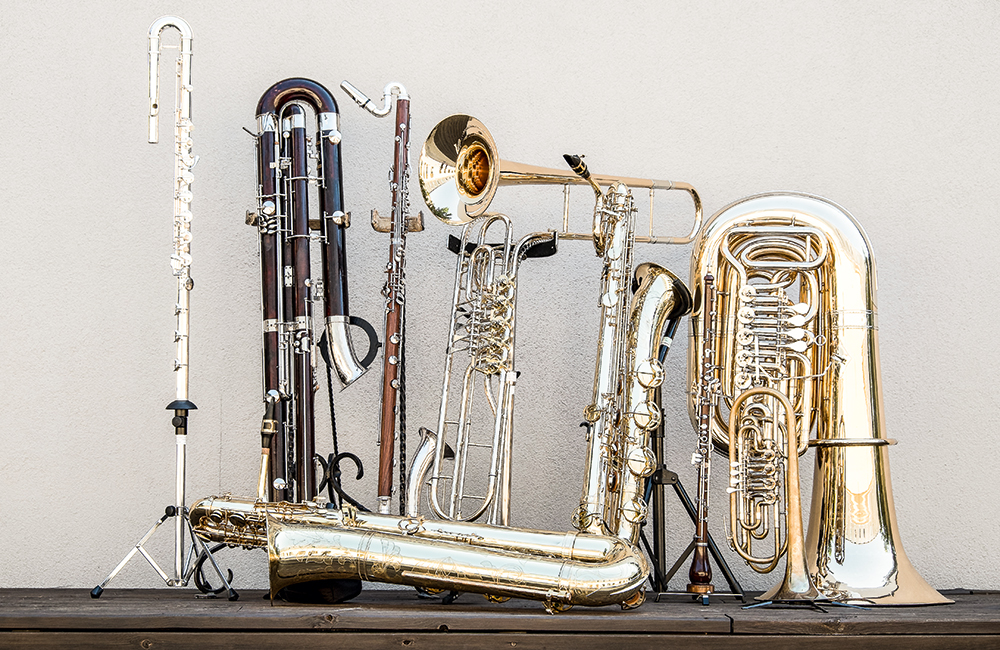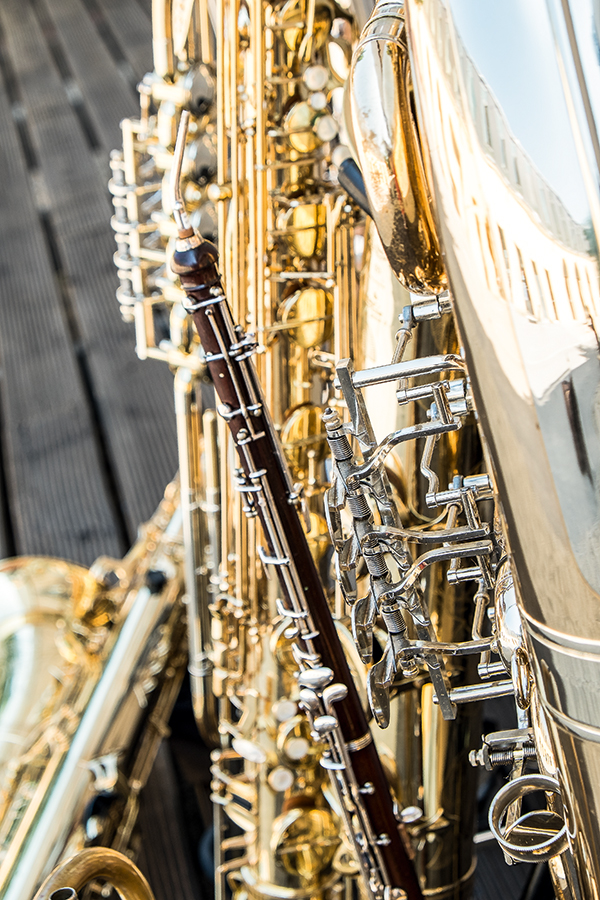Bass instruments evoke a unique fascination—they’re large and heavy, some of them could be described as unwieldy, and everything about them is bigger and more expansive than their higher-pitched relatives: string lengths, keys, distances between holes, vibrating columns of air, and reeds—which sometimes even have to be bent due to the instruments’ sizes. Playing such instruments requires a lot of breath and/or strength, their repertoires usually feature longer note-values, and a different notion of virtuosity is in play—for fast passages can be realized only with difficulty. The registers that they inhabit plumb depths where it can be difficult to distinguish between notes that lie one half-step apart, and the sounds of the notes themselves are joined by clearly audible mechanical noises and buzzes that, particularly in fast passages, can overpower the notes’ nominal pitches. The sound of the contrabassoon, for instance, is characterised by a buzz that arises from the peculiar structure of the instrument’s overtones, with the fundamental itself being so weak as to seem completely irrelevant.

At the mdw, low and ultra-low wind instruments are taught as a matter of course. Contrabassoon, bass saxophone, bass clarinet, basset horn, bass flute, bass recorder, cor anglais (English horn), heckelphone, bass trumpet, bass tuba, Wagner tuba, cimbasso, and bass trombone—all of these play a role in the teaching activities of the Leonard Bernstein Department of Wind and Percussion Instruments (performance) and the Franz Schubert Department of Wind and Percussion Instruments in Music Education.
Furthermore, the past academic year saw the mdw realise two notable projects: Low Vibrations – Im Bann der tiefen Töne! […– Fascinated by Low Notes!] not only emphasised the bass clarinet, but also paid special attention to women musicians as well as women composers who have written works for bass clarinet. 20 years ago, there were very few women who played bass clarinet as a solo instrument—but by now, not only have more women than men chosen it as their main focus, but more and more big-name women composers have also composed works for this unique instrument. A master class with Fie Schouten (Prince Claus Conservatoire Groningen) and an improvisation workshop with Ig Henneman (composer and violist) as well as a final concert presenting the rehearsed works were all held to great success in May of 2017.

A few months before, in January 2017, the mdw hosted a master class with the ensemble European Tuba Power, who had been invited to play as guest stars at the 2017 Vienna Philharmonic Ball. Andreas Martin Hofmeir, Alessandro Fossi, János Mazura, and Roland Szentpál passed on to students their know-how in terms of technique and improvisation in jazz and various other styles. This workshop was rounded out by an instrument exhibition at which an international group of tuba-makers was brought together in Vienna and students could take the opportunity to try out the exhibited instruments on the spot.
The musical world has Belgian inventor Adolphe Sax (1814 – 1894) to thank for several of these exceptional wind instruments. Sax not only invented the saxophone, which he built in a total of eight different sizes (sopranino, soprano, alto, tenor, baritone, bass, contrabass, and sub-contrabass), but also constructed his own variants of the trumpet, horn, and tuba. In 1845, having already relocated to Paris, Sax introduced his instruments to the French royal family and proposed that they be added to the ranks of their military orchestra. In response, King Louis Philippe staged a competition between a military band equipped with traditional instruments and one with the new Sax instruments. This event, held on the Champ de Mars, was attended by around 25,000 curious spectators and ended up being a fabulously effective public demonstration of Sax’s abilities and achievements.
Repertoire—particularly of the solo variety—that takes advantage of the tonal characteristics of these low wind instruments can be found most frequently in the realm of contemporary music. Above all 20th- and 21st-century composers have included them in their compositions, usually following encounters with outstanding soloists who employed special playing styles and techniques. The lower an instrument’s sound, the more capable it is of employing multiphonics, in which certain fingering techniques and/ or embouchure types produce more than one note simultaneously, making possible entire overtone-chords. Still other things become possible when soloists begin developing their own instruments further in order to realise certain compositional techniques—such as Ernesto Molinari, who performs works using a giant contrabass clarinet and live electronics. Other important contemporary works include Art of Metal for contrabass clarinet by Yann Robin, Fama by Beat Furrer (the required orchestral forces include a bass flute, a contrabass flute, a bass clarinet, and a contrabassoon), and La profondeur by Georg Friedrich Haas (which calls for a bass clarinet, a contrabass clarinet, a baritone saxophone, and a “contraforte”—a new form of contrabassoon). The bass flute, on the other hand, is used frequently in chamber music, such as in Salvatore Sciarrino’s Quaderno di strada. This work was performed in a themed concert at the mdw in 2015 and can be accessed via the mdwMediathek.
- More on the gender project Low Vibrations – Im Bann der tiefen Töne!: mediathek.mdw.ac.at/low-vibration
- Quaderno di strada by Salvatore Sciarrino in concert at the mdw: www.mdw.ac.at/mdwMediathek/Sciarrino

